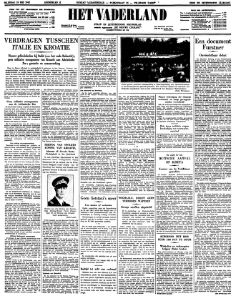About the day » Monday May 19, 1941Calender converter
Born on Monday May 19, 1941
- Geertruida Everharda Wibier († 1988)
- Frederik Christiaan Buitenhuis († 2007)
- Dennis Drysdale Drysdale Singers, Pahiatua, Tararua District, Manawatu-Wanganui, New Zealand († 1995)
- Herman Vinke († 1986)
- Donna Reekers, USA († 1941)
- Egbertus Willibrordus Bonifacius (Bertie) Stiekema († 1961)
- Jacob Hendrik Maria van Beekum, Arnhem, Gelderland, Nederland († 2009)
- Christiaan Letzer, Middelburg († 2004)
- Anna J. M. Libens, Horpmaal, België († 1941)
- Christiaan Letzer, Middelburg († 2004)
Died on Monday May 19, 1941
- Adolf (Doppie) Mol (3), Zandvoort
- Andries Rosien (80), Emmen,Drenthe,Netherlands
- Aaltje Lenstra (82), Weststellingwerf (Kantoor Wolvega)
- Andries ROOSIEN (80), Nieuw-Weerdinge, Drenthe, Nederland
- Aleida Gratema (65), Den Dolder
- Alida Wilhelmina IJpeij (78), 's-Gravenhage
- Aleida Gratama (66), Zeist
- Ann Nixon (78)
- Alphonse Brisson (72), St-Fabien-de-Panet, Montmagny, QC
- Aleida Johanna Maria Heerdink (82), Eindhoven
Source: Delpher (KB | national library) Newspapers from May 19, 1941 at Delpher
- De vrije pers : orgaan ter voorlichting van het Nederlandsche volk
- Limburgsch dagblad
- Limburger koerier : provinciaal dagblad
- Nieuwsblad van het Noorden
- Noordbrabantsch dagblad het huisgezin
- Nieuwsblad van Friesland : Hepkema's courant
- Het Vaderland : staat- en letterkundig nieuwsblad
- De banier : staatkundig gereformeerd dagblad
- Nieuwe Tilburgsche Courant
- Delftsche courant : nieuwsblad voor Delft en Delfland
Born on May 19
- 1939 » Jānis Lūsis, Latvian javelin thrower and coach († 2020)
- 1939 » James Fox, English actor
- 1939 » Livio Berruti, Italian sprinter
- 1939 » Nancy Kwan, Hong Kong-American actress and makeup artist
- 1940 » Jan Janssen, Dutch cyclist
- 1940 » Mickey Newbury, American country/pop singer-songwriter († 2002)
- 1941 » Igor Judge, Baron Judge, Maltese-English lawyer and judge, Lord Chief Justice of England and Wales
- 1941 » Nora Ephron, American director, producer, and screenwriter († 2012)
- 1942 » Gary Kildall, American computer scientist, founded Digital Research Inc. († 1994)
- 1942 » Robert Kilroy-Silk, English television host and politician
Died on May 19
- 1935 » T. E. Lawrence, British colonel and archaeologist (b. 1888)
- 1936 » Muhammad Marmaduke Pickthall, British Islamic scholar (b. 1875)
- 1939 » Ahmet Ağaoğlu, Azerbaijani-Turkish journalist and publicist (b. 1869)
- 1943 » Kristjan Raud, Estonian painter and illustrator (b. 1865)
- 1945 » Philipp Bouhler, German soldier and politician (b. 1889)
- 1946 » Booth Tarkington, American novelist and dramatist (b. 1869)
- 1950 » Daniel Ciugureanu, Romanian physician and politician, Prime Minister of Moldova (b. 1884)
- 1954 » Charles Ives, American composer and educator (b. 1874)
- 1958 » Archie Scott Brown, Scottish race car driver (b. 1927)
- 1958 » Jadunath Sarkar, Indian historian (b. 1870)
Names that were popular for boys in 1941
Names that were popular for girls in 1941
Source: Wikipedia Historical events 1941
- Koningin Wilhelmina (Huis van Oranje-Nassau) was from 1890 till 1948 sovereign of the Netherlands (also known as Koninkrijk der Nederlanden)
- In The Netherlands , there was from September 3, 1940 to July 27, 1941 the cabinet Gerbrandy I, with Prof. dr. P.S. Gerbrandy (ARP) as prime minister.
- In The Netherlands , there was from July 27, 1941 to February 23, 1945 the cabinet Gerbrandy II, with Prof. dr. P.S. Gerbrandy (ARP) as prime minister.
- The Netherlands had about 8.9 million citizens.
- March 25 » The Kingdom of Yugoslavia joins the Axis powers with the signing of the Tripartite Pact.
- May 9 » World War II: The German submarine U-110 is captured by the Royal Navy. On board is the latest Enigma machine which Allied cryptographers later use to break coded German messages.
- May 10 » World War II: Rudolf Hess parachutes into Scotland to try to negotiate a peace deal between the United Kingdom and Nazi Germany.
- July 13 » World War II: Montenegrins begin a popular uprising against the Axis powers (Trinaestojulski ustanak).
- December 10 » World War II: The Royal Navy capital ships HMSPrince of Wales and HMSRepulse are sunk by Imperial Japanese Navy torpedo bombers near British Malaya.
- December 12 » World War II: Fifty-four Japanese A6M Zero fighters raid Batangas Field, Philippines. Jesús Villamor and four Filipino fighter pilots fend them off; César Basa is killed.
Weather May 19, 1941
The temperature on May 19, 1941 was between 5.9 °C and 15.6 °C and averaged 11.3 °C. There was 12.0 mm of rain during 5.7 hours. There was 2.9 hours of sunshine (18%). The average windspeed was 3 Bft (moderate breeze) and was prevailing from the southwest.

 May 18, 1941
May 18, 1941